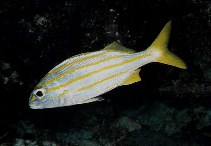| Family: |
Haemulidae (Grunts), subfamily: Haemulinae |
| Max. size: |
23 cm TL (male/unsexed) |
| Environment: |
reef-associated; marine; depth range 0 - 25 m |
| Distribution: |
Western Atlantic: southern Florida (USA) to Brazil including the Antilles. |
| Diagnosis: |
Dorsal spines (total): 12-12; Dorsal soft rays (total): 13-13; Anal spines: 3-3; Anal soft rays: 9-10. 6 straight, even, and nearly equally wide bronze-yellow stripes on side (Ref. 26938). Snout short, mouth nearly horizontal and small, the maxilla usually not reaching a vertical at front edge of pupil; fins largely yellow (Ref. 13442). |
| Biology: |
Inhabits exposed rocky areas and coral reefs. Often near elkhorn and staghorn corals (Ref. 9710). Commonly found in schools. Juveniles are encountered in Thalassia beds (Ref. 9626). Adults are observed in coral reefs during the day but enters open waters at night to feed on mainly on plankton (Ref. 9626), but also on small crustaceans and mollusks. Marketed fresh (Ref. 3798). |
| IUCN Red List Status: |
Least Concern (LC); Date assessed: 01 March 2011 Ref. (130435)
|
| Threat to humans: |
harmless |
Source and more info: www.fishbase.org. For personal, classroom, and other internal use only. Not for publication.

